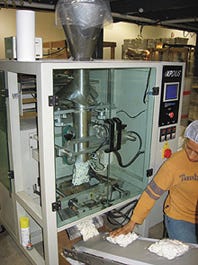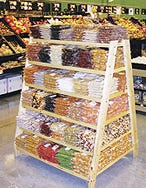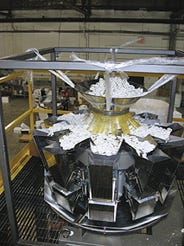Vertical form/fill/seal machine runs dry products

The PLC on the vf/f/s machine maintains the recipes for all of the products in memory, and the operator can recall them at a touch.
International Foodsource, LLC supplies high quality, natural dried food products from all over the world to customers in the U.S. The major part of its business is retail accounts, such as the H-E-B grocery store chain headquartered in San Antonio, TX, but it also supplies larger-size packages of products to foodservice companies. IFS was started in 2004 and moved into its present 100,000-sq-ft facility in 2006, where it is currently running more than 1,000 stock-keeping units, some packaged in up to seven configurations ranging from small retail packs to large industrial sizes.
Since its founding, IFS has purchased 13 automatic scales and bagging machines from Weighpack Systems, Inc. (www.weighpack.com), ranging from their first in 1996, a two-lane Tigerscale and Zippy bagger that run preformed bags, to their current high-speed vertical form/fill/seal machines with overhead combination radial weighing systems. In fact, IFS president David Lipson bought the first bagging machine that Weighpack ever built. "I'm very happy with Weighpack," he says. "Their pricing is very reasonable, and their machines are extremely rugged and high quality. I run a lot of product, and if the machines weren't as tough as they are, I'd break them."
Most recently, IFS has installed two XPdius 800 vertical form/fill/seal machines equipped with 10-head radial scale systems from CombiScale (www.combiscale.com). In this operation, a roll of film is mounted on the back of the XPdius machine and is pulled into the forming section by two servo-driven pull belts. The film passes over a series of rollers and dancer bars at the top of the f/f/s machine that maintain the proper back pressure on the film as it is pulled continuously through the machine. The film passes around a forming tube on the front of the unit, and a vertical heating element produces the vertical overlap seal. During PD's visit, the line was running yogurt-covered pretzels, and these drop intermittently from the overhead weighing system through the forming tube into the intermittently moving, formed cylinder of film as it leaves the vertical forming section.

Next, the film passes through the servo-driven sealing jaws, which move in against the film and induction-heat a horizontal seal across the film. At the end of each sealing cycle, before the jaws disengage, an air-actuated blade shoots out from the center of the jaws and cuts the bag loose, after which it drops onto the takeaway conveyor.
Although it is not needed for the clear film that IFS is running, the vf/f/s is equipped with a sensor mounted on the film carriage that detects the eye mark on the film. If the plant were running printed film with such an eye mark or registration spot, this sensor would initiate the start of each cycle. It compensates for any slight changes in the film length and ensures that the film for each bag would always be in perfect registration. This system basically tells the horizontal sealer and cutoff knife when to energize. The machine is controlled by an Allen-Bradley programmable-logic controller and incorporates an A-B PanelView operator panel and A-B Ultra 3000 servo drives that operate the vertical sealer, the left and right pulling belts and the seal jaws/knife assembly. The Allen-Bradley components are supplied by Rockwell Automation (www.rockwellautomation.com).
For more information about form/fill/seal operations, visit Packaging Digest's FILL, F/F/S TECHNOLOGY CHANNEL at www.packagingdigest.com/ info/formfill
The PLC maintains the recipes for all of the products in memory, and the operator can recall them at a touch. The unit automatically sets the operating parameters, including the sealer temperatures and the servo drives that, among other things, set bag length. The screen can also be actuated to display the settings currently in use, causes of operating problems and maintenance requirements.
Product for the vf/f/s machine is weighed by the 10-head CombiScale radial-weighing system that is located on a platform above the machine. Bins of product are lifted onto the platform by a fork truck, and a worker loads it into an elevator that delivers it to a funnel that discharges onto the weigher's dispersion table.
The dispersion pans transfer the product to the 10 radial feeder hoppers, which, in turn, move the product by vibration to the weigh buckets. Each radial feeder adjusts the strength and duration of vibration to ensure an ample supply to the hopper. Once the product is in the hoppers, the weigher's computer selects a combination of buckets (generally three or four) that cumulatively equals the closest weight to the total bag weight without being under that weight. The selected hoppers then open and discharge their contents down the discharge chute to the bagger.

Product for the vf/f/s machine is weighed by the 10-head CombiScale radial-weighing system that is located on a platform above the machine.
The scale features an easy-to-use computer-controlled operator interface that provides a clear display of charge weight as well as various statistical data. The interface is located on the first floor next to the bagging machine, so the operator can interact without climbing up to the platform. The scale also is designed for easy sanitation by featuring simplified cleaning. Product contact parts are easily removed without tools.
Bags drop from the vf/f/s onto an upward inclined conveyor that discharges onto a horizontal conveyor where a worker applies a label to each bag. The labels are dispensed from a roll by a Dispensa-Matic U-45 power-advance label dispenser from M-Pak Systems, Inc. (www.mpaksys.homestead.com). In this operation, each time the worker picks a label, the dispenser automatically peels the next label from the roll and presents it for application.
Because of the huge number of bulk products it receives and the number of skus in its inventory, IFS puts a major emphasis on tracking its products, beginning with incoming products and continuing through every lot of finished products. "We receive dried products from all over the world, and for every container of incoming product, we print a label that contains a lot number that enables us to track who produced it, where it came from and when we received it," says Lipson. "This raw product lot number goes with the product through the packaging operations, and every finished package has its own label with its lot number or expiration date that connects to the incoming product lot number and also tells when that package was produced and on what packaging line."
The labels are printed on Z4mPlus thermal-transfer printers from Zebra Technologies International, LLC (www.zebra.com). The data is accumulated on the company's inhouse computer and is transmitted to the individual printers over the internet. "We track our incoming-product inventory and our packaged-product inventory with their lot codes on our computer, along with orders and shipments, so we know the exact status of every product we make," says Lipson. "We use this data to schedule our daily production on our packaging lines. We may package 10 or 15 different products a day on a line, but we try to minimize the number of package-size changes we make. The computer keeps track of these requirements and optimizes the production schedule.
"Weighpack has done an excellent job for us," continues Lipson. "My work is a challenge. I run lot of different products, but Weighpack never took a negative attitude about any of it, and I've never had any problem that they couldn't handle. I bought one of the first XPdius machines, when Weighpack introduced that line, and they came down for a week to help me get it up and running. It turned out that we didn't need that much help, but it indicates their great service.
"Weighpack has done everything I asked them to, and they are at the top of my list of suppliers. In fact, I'm getting quotes from them right now for more machines." In fact, Lipson is so pleased with the Weighpack machines that he has ordered a new dual-servo driven stainless-steel-construction XPdius 1200 vf/f/s equipped with a 14-head CombiScale for even higher speeds.
More information is available:
Weighpack Systems, Inc., 514/422-080. www.weighpack.com.
CombiScale, Inc., 847/806-0606. www.combiscale.com.
M-Pak Systems, Inc., 336/378-6036. www.mpaksys.homestead.com.
Rockwell Automation, 414/382-2000. www.rockwell.com.
Zebra Technologies International, LLC, 847/634-6700. www.zebra.com.
About the Author(s)
You May Also Like


